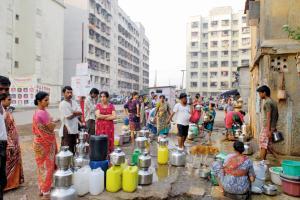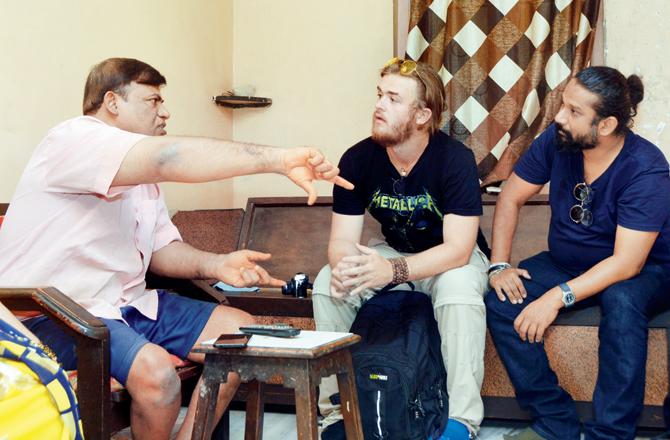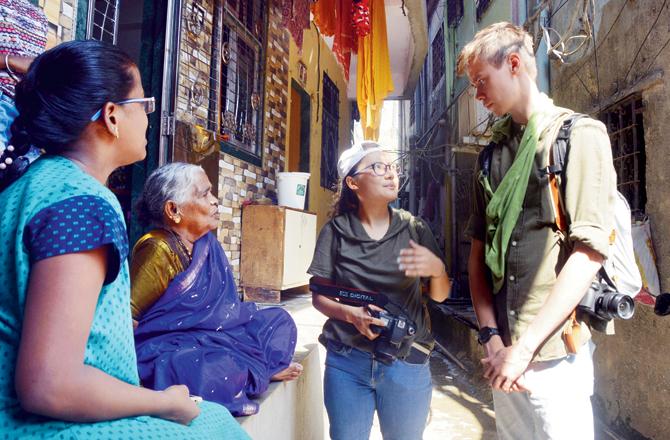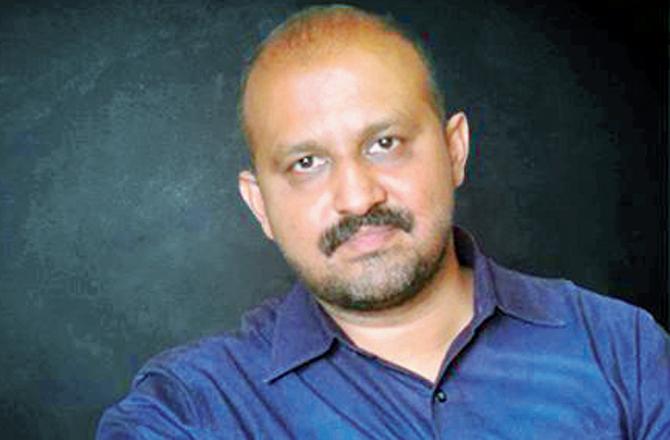A group of Australian students visit Mumbai to observe the water situation and find definitions are caught up in semantics

A photo by Atul Kasare at an exhibition by Pani Haq Samiti and Photography Promotion Trust showcased the city's water crisis
Fifty-Five-year-old Shanti Devi stands in a cramped lane inside Dharavi, queuing up to fill two buckets of water every day. About 28 litres of water collected after a 30-minute toil, she says, will suffice her family of four for a whole day. "We are used to getting limited water at odd hours," she says, adding that this exercise usually begins around 5 am. Devi's daily water collection chore might be normal for many across the city, but for a group of students from Australia's Griffith University, it points to a problem, that they argue, no one is addressing, let alone resolving.
Frogs in boiling water?
In the first week of January, 11 students from the Brisbane-based university, aged 19 to 26, arrived in Mumbai along with two supervisors, as part of a college programme titled, The Water Story. Their aim is to create a platform to discuss water woes in Mumbai and the global ramifications of the water crisis in the next decade.

Dr Kasun Ubayasiri (in blue tee) and Griffith University students speaking to separate families in Dharavi during their month-long stay in the city. Pics/Sneha Kharabe
Ashil Ranpara, placement officer, Griffith University, says, "India, with its growing population and industrialisation, has a huge stake in water security. Parts of India, primarily the west, are worse off. The groundwater is depleting and rainfall is getting scanty. Hence, we decided to select water crisis communication as a preferred topic this year and handpicked the students." The project has been funded by the Australian government's Department of Foreign Affairs and Trade's New Colombo plan. The Australians, all students of communication, are getting help from the Xavier's Institute of Communication in understanding Mumbai's geography and connecting with locals. What they have found is that Mumbaikars have adjusted to limited and unequal distribution of water, which is why no one defines it as a crisis.
Dr Kasun Ubayasiri, lecturer in communication at Griffith Univeristy, says, "We always assumed the water crisis in Mumbai was complex, but three weeks in, we are beginning to realise it is more complicated than we imagined. When we first arrived, we thought Mumbai simply had a water shortage — yet another big city trying to live beyond its means. But, we now realise the challenge is not necessarily a shortage of water, but the difficulty of distributing water equitably across different neighbourhoods and social-strata to a population of more than 20 million."

Joshua Holmes has been working closely with the Brihanmumbai Municipal Corporation (BMC) to understand its water policies. He says, "Due to lax enforcement and very little regulation, water resource policy has proven less than reliable in providing Mumbai with access to required drinking water. During my research, I found that while there are some policies on paper, their effective implementation is the problem. While some [areas] get ample water every day, some pockets [usually slums] struggle."
Interestingly, Rahiman Paani — a photo exhibition hosted by Pani Haq Samiti and Photography Promotion Trust at Jehangir Art Gallery, earlier this month, had pictures of this strata of the society on display, depicting their struggle to secure water. Award-winning photographer Sudharak Olwe, also the curator of this exhibition, says, "We collated pictures of the common man; those who help run this city, but have no access to water. These slum dwellers, rickshaw-pullers are denied their fundamental right to water. The exhibition highlighted the stark reality of everyday struggles of the 'other' Mumbaikars to secure the precious resource."

Pankaj Joshi
Enough water (but not for all)
Pankaj Joshi, executive director of the Urban Design Research Institute (UDRI), says Mumbai gets about three meters of water every monsoon season, which is enough for the current population. But, Mumbai treats this resource in a short-sighted manner. "Mumbai, the world's second-most crowded city, isn't staring at a water crisis at the moment. Usually, rainfall below 48 inches defines water crisis in a region. Though we have the resource in abundance, essentially it comes down to how you handle it, collect it, and distribute it to people." The problem, he says, is transmission loss. When water is transported from dam to reservoirs and balancing tanks, a lot of the resource is wasted. "Our 100-year-old infrastructure cannot prevent leakages. Unfortunately, the amount of water we lose during supply is equivalent to the amount Pune city gets in a day."
Mumbai's arrogance, says Joshi, is a fundamental problem, resulting in uneven distribution and consumption of the resource. He adds, "Water is metered in areas like Dahisar, Kandivali and Malad, but not in Malabar Hills. Why? While a slum resident will have to buy a bucket for R5 through tankers, the rich get 24x7 water supply from the BMC. Once UDRI did a survey at municipal schools. When we asked 10-year-olds their aspiration in terms of water supply, they didn't want it round-the-clock, but just for an hour a day. These underprivileged families usually wake up at 3 am, fill buckets and go back to sleep. It's unfair. This is because water is sent to rich neighbourhoods through the day, and the poor get the same only after midnight. Somebody needs to pay to subsidise for the rich; unfortunately, the deprived class end up bearing the brunt. The middle-class and rich are pampered."
Looking for a solution
Tony Huber, Australian Consul General, adds, "Water is an essential element of life, however both our peoples and countries share similar challenges with low rainfall, dry lands, agricultural production, urban and other needs. These common challenges and the rising demands for water call for more innovative strategies and a better understanding of water issues. These Australian students, thus, are working to develop important narratives about our shared water challenges."
When Holmes spoke to BMC's assistant hydraulic engineer, Anil Kopkar, he was told about the Pinjal and Galgai dam project. Talking to mid-day, an official, requesting anonymity, says, "The two dams have been planned under the Water Distribution and Improvement programme for equal supply of water to every citizen in the next few years. As part of another long-term plan, we will construct sewerage treatment plants, where water will be recycled and non-potable water will be supplied to citizens."
Joshi, however, believes citizens cannot rely on civic authorities alone, but every household needs to take charge of the situation. "Mumbaikars are callous about the water we get every season. Every building has a single water system. We need a dual plumbing system so that people don't use potable water to flush their toilets. The BMC needs to intervene and build the required infrastructure."
Conservation not harvesting
Pankaj Joshi says rainwater harvesting is not the solution for Mumbai due to the soil here. "We must conserve water; this can be done by building borewells in every residential society to limit wastage and recycle water. If we manage to recycle 20 per cent of the water we receive, we won't need to depend on dams."
Not mafia
Researcher Jake Kearnan, who is conducting a detailed report on Mumbai's water tanker mafia, says while the term 'mafia' holds negative connotations, "these acts of crime are acts of heroism for others'. Kearnan, says architect and urban planning consultant Sulakshana Mahajan, told him: "If it were not for the water tanker mafia, there would not be enough water for people residing in slums. Everyone exploits this mafia system, right from the elected members to the slum dwellers. We have water leakages, but we refer to them as losses. However, that isn't the case. They are, in fact, gains to those in need."
03
Meters of water Mumbai gets every monsoon
Catch up on all the latest Crime, National, International and Hatke news here. Also download the new mid-day Android and iOS apps to get latest updates
 Subscribe today by clicking the link and stay updated with the latest news!" Click here!
Subscribe today by clicking the link and stay updated with the latest news!" Click here!









